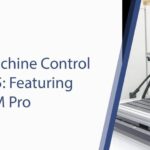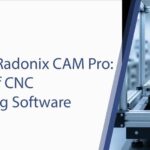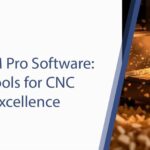In the relentless pursuit of efficiency and precision, the manufacturing industry is undergoing a profound transformation.
The days of standalone, disconnected machines are rapidly giving way to a new era of interconnected, intelligent factories. At the very heart of this revolution is the Internet of Things (IoT), and its application to one of the most critical processes in modern production: CNC milling.
The integration of CNC milling in IoT is not just an incremental improvement. It’s a paradigm shift that unlocks unprecedented levels of productivity, quality, and operational insight.
At Radonix, we understand this future and are at the forefront of providing the advanced control systems and software solutions that make CNC milling in IoT a reality.
This article will take a deep dive into CNC milling in IoT, exploring its key benefits, practical applications, and strategic importance for businesses looking to gain a competitive edge in modern manufacturing.
What is CNC Milling in IoT?
At its core, CNC milling in IoT is the process of connecting CNC milling machines to a network to enable seamless data exchange.
This is achieved by outfitting machines with a variety of sensors and a communication gateway, often integrated directly into modern CNC control systems.
These sensors collect real-time data on every aspect of the machine’s operation, including:
- Spindle Load: Power drawn by the spindle.
- Motor Temperature: Heat levels of axis motors and spindle motor.
- Vibration: Early indicators of tool wear or machine issues.
- Power Consumption: Energy usage during different job stages.
- Machine Status: Whether the machine is active, idle, under maintenance, or in alarm state.
The collected data is securely transmitted to a cloud-based or on-premise platform. There, it is stored, analyzed, and displayed through real-time dashboards.
This two-way communication allows for monitoring, reporting, and even remote updates to machine programs—making production floors more dynamic and responsive.
The seamless data flow in CNC milling in IoT is the foundation of the true smart factory.
Key Benefits of CNC Milling in IoT
Integrating IoT into CNC milling yields a range of transformative benefits. Here are the most significant advantages:
1. Predictive Maintenance & Reduced Downtime
One of the biggest benefits is the ability to shift from reactive or scheduled maintenance to predictive maintenance.
Sensors monitor machine health in real time, analyzing vibration, temperature, and spindle load. This data can predict when a component (like a bearing or drive) is likely to fail. Maintenance can then be scheduled proactively, avoiding costly breakdowns.
This approach saves tens of thousands of dollars in lost productivity and repair costs.
2. Real-Time Monitoring & Enhanced OEE
Overall Equipment Effectiveness (OEE) is a critical manufacturing metric. Traditionally, calculating OEE is time-consuming and prone to error.
With CNC milling in IoT, OEE is calculated automatically and in real time. Supervisors can view machine performance on dashboards, identify idle equipment, and respond instantly to issues.
The result: faster problem-solving and continuous performance improvement.
3. Process Optimization & Efficiency Gains
IoT data reveals deep insights into machining processes. By analyzing spindle loads, tool paths, and energy consumption, engineers can identify inefficiencies and optimize programs.
For example, data might show a tool path causing excess vibration. Adjustments can extend tool life, improve finish quality, and cut cycle times.
This data-driven optimization leads to higher efficiency without compromising quality.
4. Improved Quality Control
Traditional quality checks happen after production. With IoT, quality is monitored in real time.
If sensor data shows anomalies—like vibration spikes or temperature deviations—the system can alert operators or pause production. This ensures defects are caught immediately, reducing scrap rates and ensuring consistent quality.
5. Seamless Business Integration
IoT-enabled CNC milling connects directly with higher-level systems like MES (Manufacturing Execution Systems) and ERP (Enterprise Resource Planning).
This allows machine data to inform production scheduling, supply chain management, and inventory planning. For example, when a machine completes a job, MES updates automatically and ERP can trigger raw material orders.
Challenges in Implementing CNC Milling in IoT
While the benefits are powerful, implementation can pose challenges. Here are the main hurdles—and solutions:
1. Legacy Machine Integration
Many factories still use older machines. Retrofitting them with external sensors and IoT gateways is a cost-effective solution, though not as deep as new IoT-ready machines.
2. Data Security
Networking machines introduces cybersecurity risks. Using encrypted communication, strong firewalls, and regular security audits is essential to protect operations.
3. Data Management & Analysis
CNC machines generate vast data volumes. Without the right platform, data becomes overwhelming. IoT platforms with analytics and visualization tools transform raw numbers into actionable insights.
The Radonix Advantage
At Radonix, we provide the technology that makes CNC milling in IoT practical and powerful.
IIoT-Ready Control Systems
Our controllers are designed as secure gateways, collecting and transmitting spindle, axis, and sensor data in real time.
Seamless Integration
Our systems connect easily with networks and higher-level software like MES and ERP, creating a connected, future-ready environment.
Expert Guidance
We don’t just sell technology—we provide partnerships. Our team helps manufacturers choose the right sensors, configure networks, and optimize performance.
With Radonix, CNC milling in IoT becomes not just possible but a competitive advantage.
Conclusion: The Future of Smart Factories
The future of manufacturing is smart, connected, and data-driven.
CNC milling in IoT is more than an upgrade—it’s a strategic investment. It improves productivity, reduces costs, and enhances quality control while positioning your business for long-term success.
Don’t get left behind in the digital transformation. Contact Radonix today to learn how our CNC control systems and IIoT solutions can help you build a smarter, more productive factory.
Contact Us:
- E-Mail: info@radonix.com
- Phone: +90 (553) 920 5500








